Getting to Know Cells
Cells make up every living thing. Inside of each cell are genetic instructions which determine what cell type it will be, and how the cell will behave. All individuals begin with a pool of cells that are the foundation cells for every organ and tissue in the body. These cells are called stem cells which are immature cells that will divide into many different types of mature, specialized cells depending on what 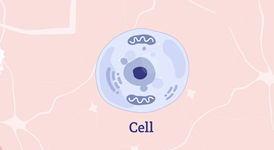 the body needs – this is called differentiation. During this process, a set of genes in the DNA of each cell are turned on or off to determine what type of cell it will turn into and what type of proteins it will create to help the body function. For example, a stem cell may be instructed, directly or indirectly, by the genes to travel to an area of the body for muscle contraction. These will become muscle cells and continue to divide and play a role in contracting one’s muscles for movement. Once a stem cell becomes a mature cell, it will stay that cell type. Throughout one's life, stem cells turn into mature cells, but certain parts of the body will keep their own supply of stem cells, such as in our bone marrow.
the body needs – this is called differentiation. During this process, a set of genes in the DNA of each cell are turned on or off to determine what type of cell it will turn into and what type of proteins it will create to help the body function. For example, a stem cell may be instructed, directly or indirectly, by the genes to travel to an area of the body for muscle contraction. These will become muscle cells and continue to divide and play a role in contracting one’s muscles for movement. Once a stem cell becomes a mature cell, it will stay that cell type. Throughout one's life, stem cells turn into mature cells, but certain parts of the body will keep their own supply of stem cells, such as in our bone marrow.
When Cells Change
The processes of cell growth, division, and differentiation can be complex. When cells grow old or become damaged, they usually die, and new cells get created to divide and to take their place. However, there are times when the body is not able to recognize a cell change, and a damaged cell continues to replicate with changed DNA. A change in the DNA changes how our cells function because it affects how the proteins in our body are built. These changes can be inherited, can happen as we age, or can be caused by environmental factors.
Many human diseases are caused by our cells not functioning properly. For example, in some types of cancer, specific cells in the body get stuck somewhere along the long path of differentiation, creating a shortage of the cell type they had intended to make. The body then tries to compensate for this shortage by having these potentially damaged cells divide many times to fill the gap. This adds to the problem by filling up the tissue with non-functional cells that will take over the normal healthy cells to survive.
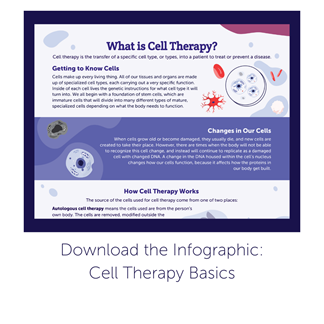 How Cell Therapy Works
How Cell Therapy Works
Cell therapy is the transfer of a specific cell type, or types, into a person to treat or prevent a disease. Many cell types have the potential to be modified and used as a therapy. Common disorders treated with cellular therapies include cancers of the blood and bone marrow, cancers of the lymphatic system, plasma cell disorders, and other conditions that affect the body’s ability to make healthy cells.
The source of the cells used for cell therapy come from one of two places:
-
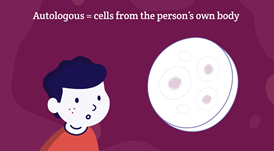 Autologous cell therapy means the cells are collected from the individual's own body. The cells are removed, modified outside the body, then the processed cells are returned to the body. Using the person's own cells makes it less likely to cause immune responses compared to the use of donor cells but will not always be a viable option. A helpful tip to remember is that ‘auto’ means self.
Autologous cell therapy means the cells are collected from the individual's own body. The cells are removed, modified outside the body, then the processed cells are returned to the body. Using the person's own cells makes it less likely to cause immune responses compared to the use of donor cells but will not always be a viable option. A helpful tip to remember is that ‘auto’ means self.
-
Allogeneic cell therapy means the cells used are from someone other than the patient, such as a healthy and compatible (or matched) donor. A helpful tip to remember this is that ‘allo’ means other.
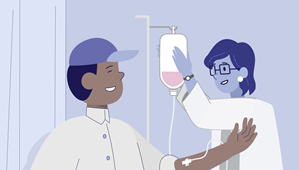
Prior to receiving a cell therapy, an individual may need to follow a pretreatment called conditioning to decrease the immune system's activity for better odds of a successful treatment. Conditioning is often a chemotherapy, which can be extremely hard on the body. It is important that all aspects of the treatment process be thoroughly explained by a healthcare professional to ensure it is well understood by the patient.
Gene modified cell therapy (or ex vivo gene therapy) is a combination of both gene and cell therapy. It first removes a person’s own cells from the body. Certain cell types are then treated by either adding a working copy of the gene or modifying/editing the affected nonfunctional gene. Ideally, the body will continue to produce mature cells with the modification when administered back to the individual. CART-cell therapy is just one example of this, but other approved treatments include cells that are modified with lentivirus for disorders such as server combined immunodeficiency (SCID), and metachromatic leukodystrophy (MLD).
Learn more about gene therapy basics and various gene and cell therapy approaches.
Types of Cells for Cell Therapy
The type of cells used for cell therapy depends on the disease being treated and the intended effect on the individual receiving treatment. Here are few commonly used types:
-
Hematopoietic (blood forming) stem cells also known as HSC’s are versatile cells that can turn into any type of blood cell the body needs and can be retrieved from the peripheral blood, from the bone marrow or from umbilical cord blood. Treatments using these cells aim to establish healthy blood cell production in individuals whose blood cells or immune cells are not working 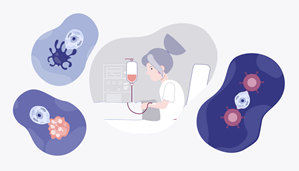 properly. A hematopoietic stem cell transplantation (HSCT), sometimes known as a bone marrow transplant (BMT), is used to treat various blood cancers and other blood disorders. HSCs are usually from a donor (allogeneic), but in some cases may use cells collected from the person’s own body (autologous).
properly. A hematopoietic stem cell transplantation (HSCT), sometimes known as a bone marrow transplant (BMT), is used to treat various blood cancers and other blood disorders. HSCs are usually from a donor (allogeneic), but in some cases may use cells collected from the person’s own body (autologous).
-
Cells of the immune system are used because they can recognize and kill cancer cells. One type of cell therapy, called CAR T-cell therapy, modifies the individual's immune cells called T-cells by adding receptors to them. When these modified cells are delivered back to the patient, they recognize, and kill cancer cells. CAR-T typically uses a person’s own cells (autologous) but in some cases, may utilize cells collected from a donor (allogenic).
Learn more about blood disorders and this treatment process in CAR T Basics.
-
Mesenchymal stem cells, most commonly found in bone marrow and fat, are the most versatile and can help the body heal in different ways depending on what is being targeted. They can act like stem cells and become the same type of cell as those in the surrounding area or act like a delivery system to bring medicine to the area in need.
Potentials, Challenges, and Risks of Cell Therapy
Potentials
Challenges
-
Matched donors. Similar to human organ transplants, immune barriers exist that require the person donating the HSC and person receiving the HSC to be carefully “matched” to avoid life-threatening complications arising from immune system not matching. Many individuals may never find someone who is a match due to lack of recruitment, diversity, and availability.
-
Accuracy required. Cell and gene therapies need to ensure modified cells go to the right tissue, at the right level, for the right amount of time. This means that a lot of research goes into the best way to deliver the cellular material.
-
Immune suppression. Chemotherapy and other conditioning regimens are often administered prior to cell therapy to prevent an immune response. The medications used to suppress an individual’s immune system can increase their risk for infections and can be quite hard on the body.
Risks
-
Informed consent. Before participating in a clinical trial or receiving a cell therapy treatment, a member of the research team should review any potential risks and benefits with the individual and/or caregiver. It is important that individuals participating in a clinical trial understand their rights during the research process and know what to expect.
-
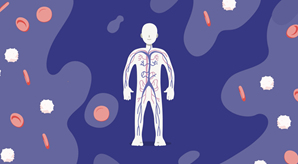 Immune responses. Graft-versus-host disease (GVHD), a syndrome that arises when immune cells present in the, transplanted HSC (the graft) recognize the recipient/host’s cells/tissues as foreign and mount an immune response that leads to the destruction of multiple host tissues.
Immune responses. Graft-versus-host disease (GVHD), a syndrome that arises when immune cells present in the, transplanted HSC (the graft) recognize the recipient/host’s cells/tissues as foreign and mount an immune response that leads to the destruction of multiple host tissues.
-
Organ toxicities. During CAR-T therapy, immune system cells become stimulated and release chemical messengers called cytokines. Too many cytokines can result in fever, trouble breathing and can be life-threatening. In the case of cytokine release syndrome, individuals may require anti-cytokine therapy.
Next, visit CAR T Basics to learn more about approved cell therapies, and cell therapy use in disease treatments for blood disorders.
Was this information helpful? If so, please share! All ASGCT Patient Education resources are free to use by sharing on social media, embedding the video, or simply linking to this page! Please credit the American Society of Gene and Cell Therapy or tag @ASGCTherapy.